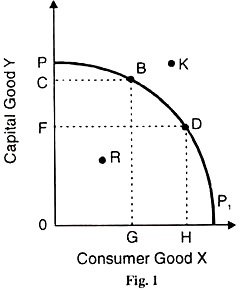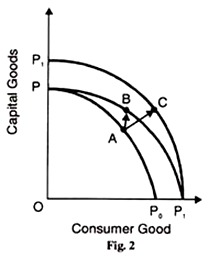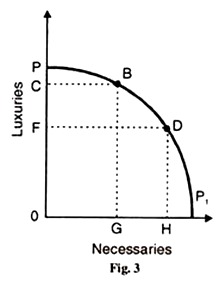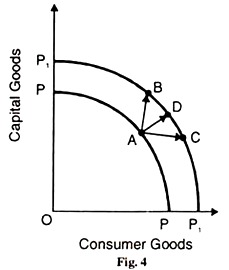The following points highlight the five basic problems of an economy. The problems are: 1. What to Produce and in What Quantities? 2. How to Produce these Goods? 3. For whom is the Goods Produced? 4. How Efficiently are the Resources being Utilised? 5. Is the Economy Growing?.
Problem # 1. What to Produce and in What Quantities?
The first central problem of an economy is to decide what goods and services are to be produced and in what quantities. This involves allocation of scarce resources in relation to the composition of total output in the economy. Since resources are scarce, the society has to decide about the goods to be produced: wheat, cloth, roads, television, power, buildings, and so on.
Once the nature of goods to be produced is decided, then their quantities are to be decided. How many tonnes of wheat, how many televisions, how many million kws of power, how many buildings, etc. Since the resources of the economy are scarce, the problem of the nature of goods and their quantities has to be decided on the basis of priorities or preferences of the society.
ADVERTISEMENTS:
If the society gives priority to the production of more consumer goods now, it will have less in the future. A higher priority on capital goods implies less consumer goods now and more in the future. But since resources are scarce, if some goods are produced in larger quantities, some other goods will have to be produced in smaller quantities.
This problem can also be explained with the help of the production possibility curve as shown in Figure 1.
Suppose the economy produces capital goods and consumer goods. In deciding the total output of the economy, the society has to choose that combination of capital goods and consumer goods which is in keeping with its resources.
It cannot choose the combination R which is inside the production possibility curve PP1 because it reflects economic inefficiency of the system in the form of unemployment of resources. Nor can it choose the combination R which is outside the current production possibilities of the society. The society lacks the resources to produce this combination of capital goods and consumer goods.
ADVERTISEMENTS:
It will, therefore, have to choose among the combinations В, E, or D which give the highest level of satisfaction. If the society decides to have more capital goods, it will choose combination B; and if it wants more consumer goods, it will choose combination D.
Problem # 2. How to Produce these Goods?
The next basic problem of an economy is to decide about the techniques or methods to be used in order to produce the required goods. This problem is primarily dependent upon the availability of resources within the economy.
If land is available in abundance, it may have extensive cultivation. If land is scarce, intensive methods of cultivation may be used. If labour is in abundance, it may use labour-intensive techniques; while in the case of labour shortage, capital-intensive techniques may be used.
The technique to be used also depends upon the type and quantity of goods to be produced. For producing capital goods and large outputs, complicated and expensive machines and techniques are required. On the other hand, simple consumer goods and small outputs require small and less expensive machines and comparatively simple techniques.
ADVERTISEMENTS:
Further, it has to be decided what goods and services are to be produced in the public sector and what goods and services in the private sector. But in choosing between different methods of production, those methods should be adopted which bring about an efficient allocation of resources and increase the overall productivity in the economy.
Suppose the economy is producing certain quantities of consumer and capital goods at point A on PP curve in Figure 2. у adopting new techniques of production, given the supplies of factors, the productive efficiency of the economy increases. As a result, the PP0 curve shifts outwards to P1P1.
It leads to the production of more quantities of consumer and capital gods from point A on PP0 curve to point С of PP with be the new production possibility curve and the economy will move from point A to В where more of both the goods are produced.
Problem # 3. For whom is the Goods Produced?
The third basic problem to be decided is the allocation of goods among the members of the society. The allocation of basic consumer goods or necessities and luxuries comforts and among the household takes place on the basis of among the distribution of national income.
Whosoever possesses the means to buy the goods may have then. A rich person may have a large share of the luxuries goods, and a poor person may have more quantities of the basic consumer goods he needs. This problem is illustrated in Figure 3 where the production possibility curve PP shows the combinations of luxuries and necessaries.
At point В on the PP curve, the economy is producing more of luxuries ОС for the rich and less of necessaries ОС for the at whereas at point D more of necessaries OH are being produced for the poor and less of luxuries OF for the rich.
Problem # 4. How Efficiently are the Resources being Utilised?
This is one of the important basic problems of an economy because having made the three earlier decisions, the society has to see whether the resources it owns are being utilised fully or not. In case the resources of the economy are lying idle, it has to find out ways and means to utilise them fully.
ADVERTISEMENTS:
If the idleness of resources, say manpower, land or capital, is due to their male allocation, the society will have to adopt such monetary, fiscal, or physical measures whereby this is corrected. This is illustrated in Figure 4 where the production possibility curve PP reflects idle resources within the economy at point A, while the production possibility curve P1P1 reflects the full utilisation of the resources at point В or C.
It is for the society to decide whether to produce more capital goods at point В or more consumer goods at point C, or both at point D at the level of full employment represented by the In an economy where the available resources are being fully utilised, it is characterised by technical efficiency or full employment.
To maintain it at this level, the economy must always be increasing the output of some goods and services by giving up something of others.
Problem # 5. Is the Economy Growing?
ADVERTISEMENTS:
The last and the most important problem is to find out whether the economy is growing through time or is it stagnant. If the economy is stagnant at any point inside the production possibility curve, says in Figure 5, it has to be moved on to the production possibility curve PP whereby the economy now produces larger quantities of consumer goods and capital goods.
Economic growth takes place through a higher rate of capital formation which consists of replacing existing capital goods with new and more productive ones by adopting more efficient production techniques or through innovations.
This leads to the outward shifting of the production possibility curve from PP to P1P1; (in Figure 5). The economy moves, say after 5 years, from point A to В or С or D on the P1P1 curve. Point С represents the situation where larger quantities of both consumer and capital goods are produced in the economy. Economic growth enables the economy to have more of both the goods.
ADVERTISEMENTS:
Conclusion:
All these central problems of an economy are interrelated and interdependent. They arise from the fundamental economic problems of scarcity of means and multiplicity of ends which lead to the problem of choice or economizing of resources.




